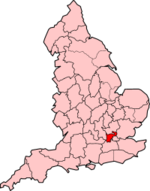History of Middlesex
| Middlesex | |||||
|---|---|---|---|---|---|
| County | |||||
|
|||||
 Middlesex within England in 1890 |
|||||
| Area | |||||
| • 1801/1881 | 734 km2 (181,320 acres) | ||||
| • 1911 | 601.8 km2 (148,701 acres) | ||||
| • 1961 | 601.7 km2 (148,691 acres) | ||||
| Area transferred | |||||
| • 1889 | Metropolitan parishes to County of London | ||||
| Population | |||||
| • 1801 | 818,129 | ||||
| • 1881 | 2,920,485 | ||||
| • 1911 | 1,126,465 | ||||
| • 1961 | 2,234,543 | ||||
| Density | |||||
| • 1801 | 11 inhabitants per hectare (4.5/acre) | ||||
| • 1881 | 40 inhabitants per hectare (16.1/acre) | ||||
| • 1911 | 19 inhabitants per hectare (7.6/acre) | ||||
| • 1961 | 37 inhabitants per hectare (15/acre) | ||||
| History | |||||
| • Preceded by | Kingdom of Essex | ||||
| • Origin | Middle Saxons | ||||
| • Created | In antiquity | ||||
| • Abolished | 1965 | ||||
| • Succeeded by |
Greater London Hertfordshire Surrey |
||||
| Status |
Ceremonial county (until 1965) Administrative county (1889–1965) |
||||
| Chapman code | MDX | ||||
| Government |
Middlesex Quarter Sessions (until 1889) Within The Metropolis: Metropolitan Board of Works (1855–1889) Middlesex County Council (1889–1965) |
||||
| • HQ | see text | ||||
| Subdivisions | |||||
| • Type |
Hundreds (ancient) Districts (1835–1965) |
||||
Middlesex (/ˈmɪdəlsɛks/, abbreviation: Middx) is a historic county in south-east England. It is now entirely within the wider urbanised area of London. Its area is now also mostly within the ceremonial county of Greater London, with small sections in other neighbouring ceremonial counties. It was established in the Anglo-Saxon system from the territory of the Middle Saxons, and existed as an official unit until 1965. The historic county includes land stretching north of the River Thames from 3 miles (5 km) east to 17 miles (27 km) west of the City of London with the rivers Colne and Lea and a ridge of hills as the other boundaries. The largely low-lying county, dominated by clay in its north and alluvium on gravel in its south, was the second smallest county by area in 1831.
The City of London was a county in its own right from the 12th century and was able to exert political control over Middlesex. Westminster Abbey dominated most of the early financial, judicial and ecclesiastical aspects of the county. As London grew into Middlesex, the Corporation of London resisted attempts to expand the city boundaries into the county, which posed problems for the administration of local government and justice. In the 18th and 19th centuries the population density was especially high in the southeast of the county, including the East End and West End of London. From 1855 the southeast was administered, with sections of Kent and Surrey, as part of the area of the Metropolitan Board of Works. When county councils were introduced in England in 1889 about 20% of the area of Middlesex, along with a third of its population, was transferred to the new County of London and the remainder became an administrative county governed by the Middlesex County Council that met regularly at the Middlesex Guildhall in Westminster, in the County of London. The City of London, and Middlesex, became separate counties for other purposes and Middlesex regained the right to appoint its own sheriff, lost in 1199.
...
Wikipedia


